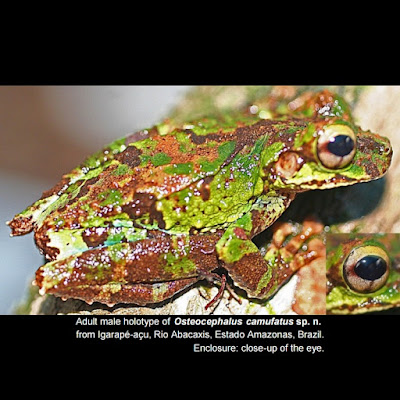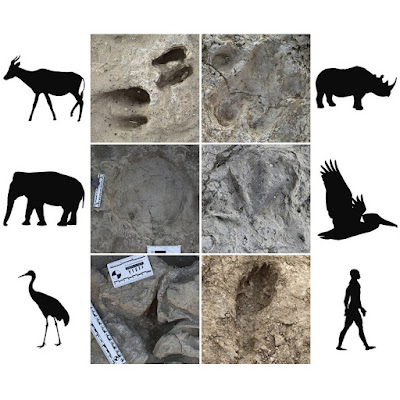[Most Recent Entries] [Calendar View]
Monday, May 23rd, 2016
| Time | Event | ||
| 10:04a | [Herpetology • 2016] Osteocephalus camufatus • A New Species of Spiny-backed Treefrog (Hylidae: Osteocephalus) from Central Amazonian Brazil
Abstract A new species of treefrog of the genus Osteocephalus is described from the Rio Abacaxis, a southern tributary of the Amazonas in the state of Amazonas, Brazil. This member of the O. buckleyi group is characterized by green dorsal colouration with irregular blotches of various shades of brown, light venter with tan spots and bold dark markings on the posterior surfaces of the thighs. It can be distinguished from its closest relative, O. helenae from the same general area, by the lack of an axillary membrane, a few indistinct tubercles on the proximal segment of Finger IV and single ulnar tubercles. Keywords: Amphibia, Anura, Hylidae; Amazonia, Brazil, Osteocephalus camufatus sp. nov. Osteocephalus camufatus sp. n. Osteocephalus buckleyi [Ca1_MTR12779_2748] — Jungfer et al. 2013 Etymology. The species name camufatus is the Latinized past participle of Italian camuffare, to disguise or mask, from which the word camouflaged is derived, in allusion to the shape-dissolving pattern of greens and browns of the new species. Relationships. A molecular phylogenetic study (Jungfer et al. 2013) revealed that the new species is most closely related and sister to a clade consisting of the polymorphic and widely distributed O. helenae, a species occurring from coastal Guyana in the north throughout most of Amazonia, to Bolivia in the southwest, but is only distantly related to the morphologically similar O. buckleyi. Karl-Heinz Jungfer, Vanessa K. Verdade, Julián Faivovich and Miguel T. Rodrigues. 2016. A New Species of Spiny-backed Treefrog (Osteocephalus) from Central Amazonian Brazil (Amphibia: Anura: Hylidae). Zootaxa. 4114(2); DOI: 10.11646/zootaxa.4114.2.6 ResearchGate.net/publication/303442699_A | ||
| 3:16p | [PaleoAnthropology • 2016] Pleistocene Footprints Show Intensive Use of Lake Margin Habitats by Homo erectus groups
Abstract Reconstructing hominin paleoecology is critical for understanding our ancestors’ diets, social organizations and interactions with other animals. Most paleoecological models lack fine-scale resolution due to fossil hominin scarcity and the time-averaged accumulation of faunal assemblages. Here we present data from 481 fossil tracks from northwestern Kenya, including 97 hominin footprints attributed to Homo erectus. These tracks are found in multiple sedimentary layers spanning approximately 20 thousand years. Taphonomic experiments show that each of these trackways represents minutes to no more than a few days in the lives of the individuals moving across these paleolandscapes. The geology and associated vertebrate fauna place these tracks in a deltaic setting, near a lakeshore bordered by open grasslands. Hominin footprints are disproportionately abundant in this lake margin environment, relative to hominin skeletal fossil frequency in the same deposits. Accounting for preservation bias, this abundance of hominin footprints indicates repeated use of lakeshore habitats by Homo erectus. Clusters of very large prints moving in the same direction further suggest these hominins traversed this lakeshore in multi-male groups. Such reliance on near water environments, and possibly aquatic-linked foods, may have influenced hominin foraging behavior and migratory routes across and out of Africa. Geology and Depositional Context We report here on 481 identifiable fossil tracks (Fig. 1), including 97 hominin footprints, found near the town of Ileret in northwestern Kenya. A small assemblage of hominin and other animal tracks was initially discovered in 200621. The excavation of this site has continued over the past 9 years, and new excavations were conducted in 2013–2014 at three additional targeted localities where hominin prints were also found. Twenty randomly selected test squares also were excavated, totaling 114 m2 of uncovered track surface. These surfaces are located within the Okote Member of the Koobi Fora Formation and are tightly time bracketed between fluvially reworked volcanic tuffs. The Northern Ileret Tuff caps the sequence and is radiometrically dated to 1.51–1.52 Ma, while the underlying Lower Ileret Tuff is dated to 1.53 Ma22,23. Between these tuffs is ~8.5 m of massive and laminated silts interspersed with fine grained, stratified and cross-stratified sands (Fig. 2). This complex is divided near the middle by the Ileret Tuff, dated to 1.52 Ma21. Neil T. Roach, Kevin G. Hatala, Kelly R. Ostrofsky, Brian Villmoare, Jonathan S. Reeves, Andrew Du, David R. Braun, John W. K. Harris, Anna K. Behrensmeyer and Brian G. Richmond. 2016. Pleistocene Footprints Show Intensive Use of Lake Margin Habitats by Homo erectus groups. Scientific Reports. 6, Article number: 26374. DOI: 10.1038/srep26374 | ||
| 3:53p | [Botany • 2016] An Expansion of the Genus Deinostigma (Gesneriaceae) in Vietnam and China ABSTRACT Based on molecular, morphological and cytological studies the previously monotypic genus Deinostigma W.T.Wang & Z.Y.Li has been expanded to include several species previously ascribed to Primulina Hance. Deinostigma now comprises seven species, including one previously placed in synonymy. The new combinations Deinostigma cicatricosa (W.T.Wang) D.J.Middleton & Mich.Möller, Deinostigma cycnostyla (B.L.Burtt) D.J.Middleton & H.J.Atkins, Deinostigma cyrtocarpa (D.Fang & L.Zeng) Mich.Möller & H.J.Atkins, Deinostigma eberhardtii (Pellegr.) D.J.Middleton & H.J.Atkins, Deinostigma minutihamata (D.Wood) D.J.Middleton & H.J.Atkins and Deinostigma tamiana (B.L.Burtt) D.J.Middleton & H.J.Atkins are made. Deinostigma eberhardtii is lectotypified. The genus is defined by a combination of an alternate leaf arrangement, hooked hairs on many plant parts, flowers with the pedicel inserted at an angle and off-centre on the receptacle, and, where known, a somatic chromosome number (2n) of < 36. This new circumscription of the genus expands its distribution from Vietnam into South China. Keywords. Molecular phylogeny, ovary morphology, Primulina, taxonomy M. Möller, K. Nishii, H.J. Atkins, H.H. Kong, M. Kang, Y.G. Wei, F. Wen, X. Hong and D.J. Middleton. 2016. An Expansion of the Genus Deinostigma (Gesneriaceae). Gardens’ Bulletin Singapore. 68(1): 145–172. |
| << Previous Day |
2016/05/23 [Calendar] |
Next Day >> |






